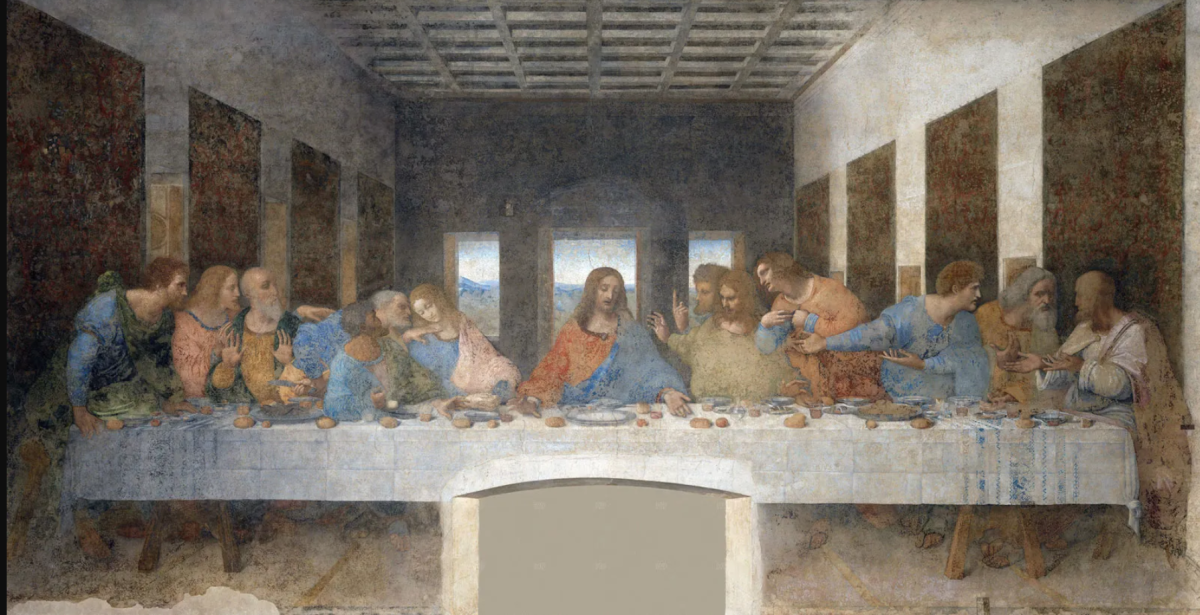The Last Supper was painted in the dining hall of the Convert of Santa Maria Delle Grazie, a Dominican convent in Milan, Italy. The painting was directly applied to the wall of the refectory, where the monks would eat their meal. It was created between 1485 and 1498. It depicts the moment Jesus announces that one of his disciples will betray him.
THE ARTIST
Leonardo Da Vinci, was an Italian polymath whose expertise spanned multiple fields, making him one of the most influential figures of the Renaissance. One of the most intriguing personalities in the history of Western art. Trained in Florence as a painter and sculptor in the workshop of Andrea del Verrocchio (1435–1488), Leonardo is also celebrated for his scientific contributions. His curiosity and insatiable hunger for knowledge never left him. He was constantly observing, experimenting, and inventing, and drawing was, for him, a tool for recording his investigation of nature. Although completed works by Leonardo are few, he left a large body of drawings (almost 2,500) that record his ideas, most still gathered into notebooks. He was principally active in Florence (1472–ca. 1482, 1500–1508) and Milan (ca. 1482–99, 1508–13), but spent the last years of his life in Rome (1513–16) and France (1516/17–1519), where he died. His genius as an artist and inventor continues to inspire artists and scientists alike centuries after his death.
INFLUENCE
Leonardo’s use of linear perspective creates a striking sense of depth, drawing viewers into the scene. The lines of the architecture converge toward Chirst’s head , emphasizing his central importance in the composition. Leonardo introduced a sense of movement, emotion, and individually to each apostle. This painting captures the range of human emotions in a way that had never been done before in religious art. Each disciple reacts uniquely to Jesus’s announcement of betrayal, expressing shock, disbelief, and even guilt. This emotional depth adds a level of psychological complexity that resonated with viewers then and continues to do so today. The painting blends spiritual themes with humanistic values, reflecting the Renaissance ideals of combining religious faith with a deeper understanding of humanity.
Jesus forms a triangle shape at the center, symbolizing the holy trinity, while the groups of apostles are divided into threes, reinforcing this spiritual symbolism. The Last Supper has become a cultural icon, referenced in countless books, films, and discussions, from theological debates to popular culture
IN HUMAN NATURE
The Last Supper captures a wide range of emotions that are inherent to human nature, such as shock, fear, anger, confusion, and sorrow. Each of the apostles reacts differently to Jesus’ announcement that one of them will betray him showing how individuals respond uniquely to crisis and uncertainty. The diversity of reactions reflects the complexity of human emotions, reminding viewers that people process and express their feelings in different ways, especially when faced with a moral or ethical dilemma.
The painting reflects at the same time the reality of human nature, the reaction of the apostles is diverse, some worried about what will happen, calm because it is not them or anxious to discover who it will be. The tranquility of Jesus in the image lets us know that the most powerful being in our world was not worried about it, he was a little sad. It can be seen in the painting that it has a way of showing what Leonardo da Vinci called “motions of the soul”; this is literally a way of showing the fullness of human emotions in art. Human nature is simply amazing and we have a very good example at the Last Supper.

